I drove out to the Percheron World Congress with much anticipation. Right there, next to the parking lot, was what I’d come to see. Massive work horses, doing what they’ve done for centuries – working alongside their people.
This was teamwork, both between the horses themselves,
and between the animals and their plowman (and, for some, plow-woman.) One horse is the furrow horse, The other walks on the land yet to be tilled. In this competition the team is judged on how straight they go and how uniform the depth of the furrow is. Note that the reins are around the man’s neck. The horses respond to voice cues, only rarely does the plowman tug on a rein.
I chatted with some of the plowmen and women, and spectators. It was a small group. Wives told me that this is what their husbands do for fun. None of these horses are necessary for their farms (although I did see some Mennonites, and perhaps they relied more on horsepower.) But, the horses do seem to be necessary for their hearts. It’s a day in, day out, commitment of time and resources. Folks joked about it, but no one regretted it.
These horses are huge, but their temperaments are calm. They have to be, to have the patience to stand in a field. There was a lot of affection shown between the horses and people.
After watching the plowing contest, I went into the Coliseum to see the show horses. These horses were even more massive. Here is a champion stallion.
At first glance, these gleaming, polished animals are glorious. The show horses are from a lineage used to pull heavy carriages, and to go at a trot for long distances. But, these days the distance traveled is more likely around a ring in front of a judge. LIke so many show animals, (purebred dogs come to mind) these Percherons have been bred for extreme looks and movement.
Spectacular. But, look closely.
The hooves are grown out, as large as they can go, to the point that they crack and have to be filled in with putty.
The shoes are weighted. This is what causes that fancy action. Polish hides only so much.
For comparison, here are the feet of a Percheron plow horse. As big as dinner plates, but natural in shape. Tonka weighs 1,000 pounds less, but this is how he is shod.
The shoeing isn’t the only way to get the flashy action in the show ring. For in-hand classes, whips are waved at the horses, scaring them into erect posture and pricked ears. This is the antithesis of what the plowmen want. (As an aside, you can train alert, arched posture using positive reinforcement. No threats necessary.)
Check reins are used to hold the heads up. See that strap going through the mouth and up towards the ears? It has no purpose except to create an upright carriage.
Once my eyes saw what was going on under the all of the flashiness, it was hard to watch.
There were a few carriage teams that did not buy into the saddlebred look. Those horses had naturally-shaped hooves, and even had full tails (Percherons usually have docked tails – most of the tail, including the bone – is cut off – which means they can’t flick flies. Supposedly this is done to keep the tails from getting tangled in harness but it is unnecessary and cruel.) None of those teams won ribbons.
So, I went back outside to watch the plow horses.
Authentic. Worth preserving.
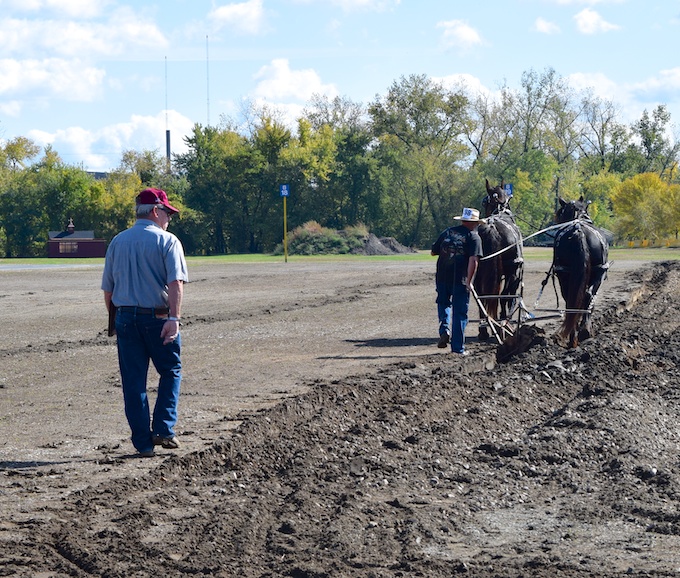
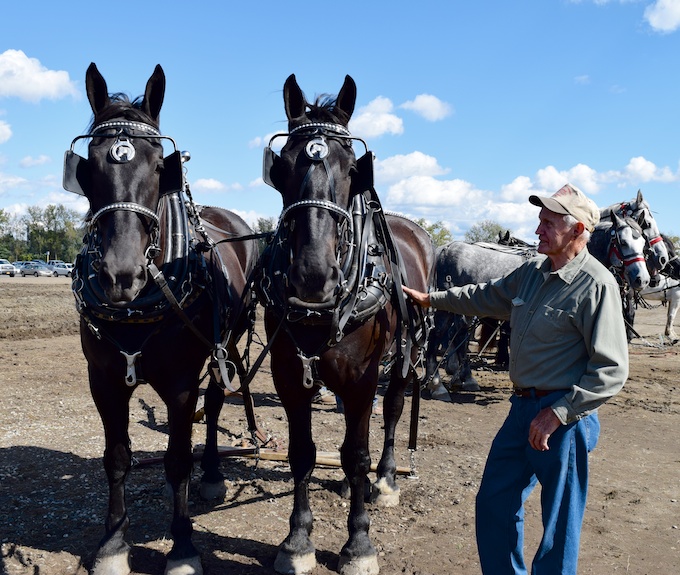
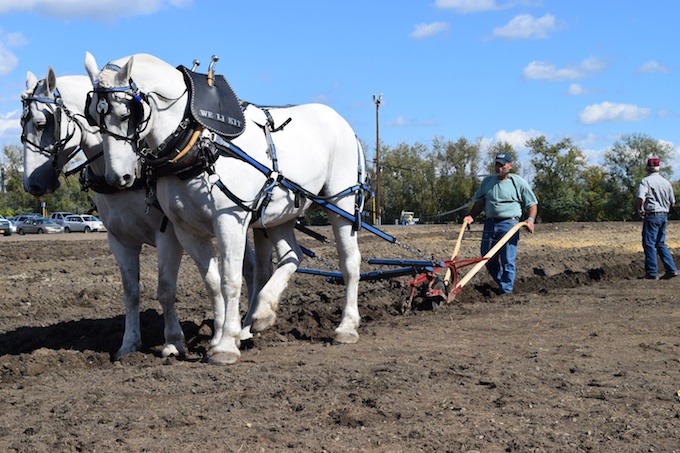
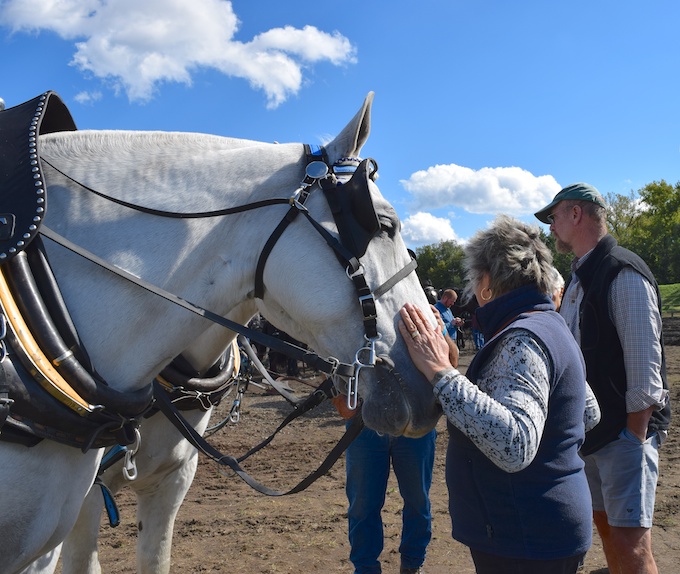
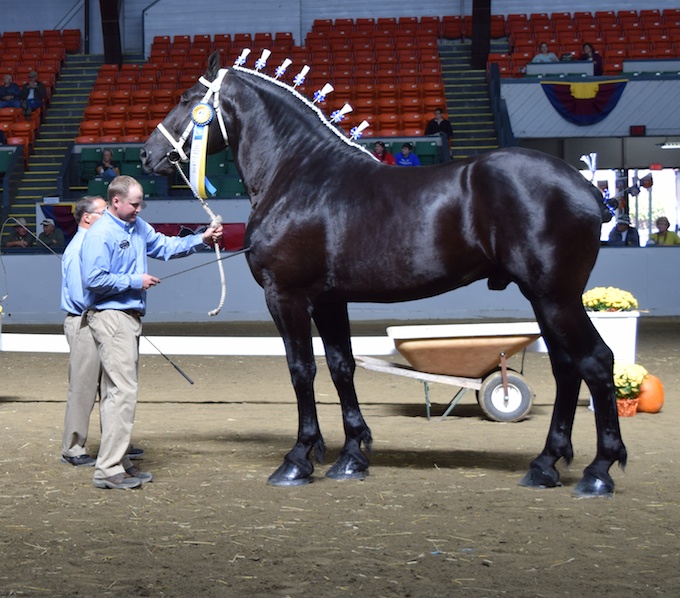
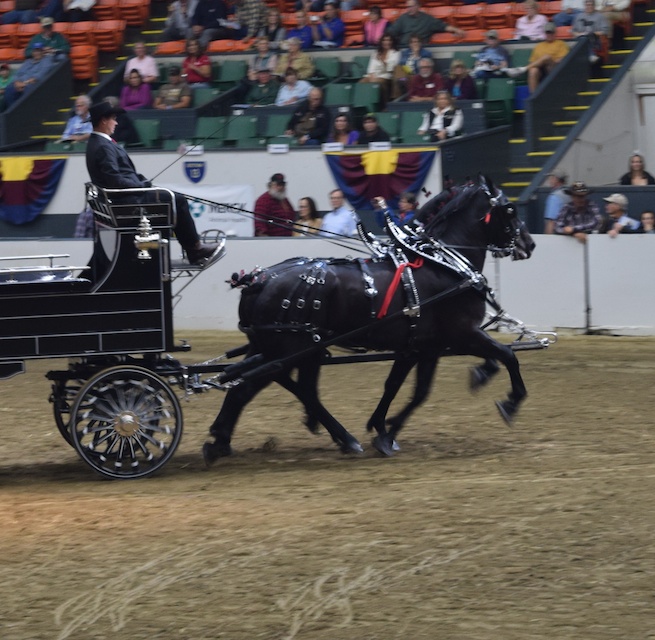
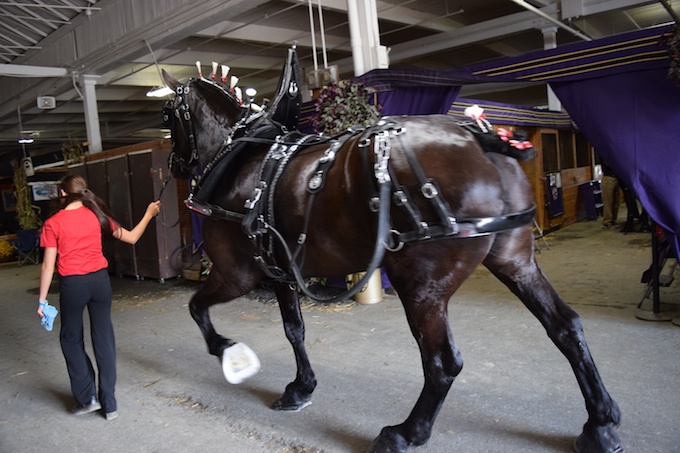


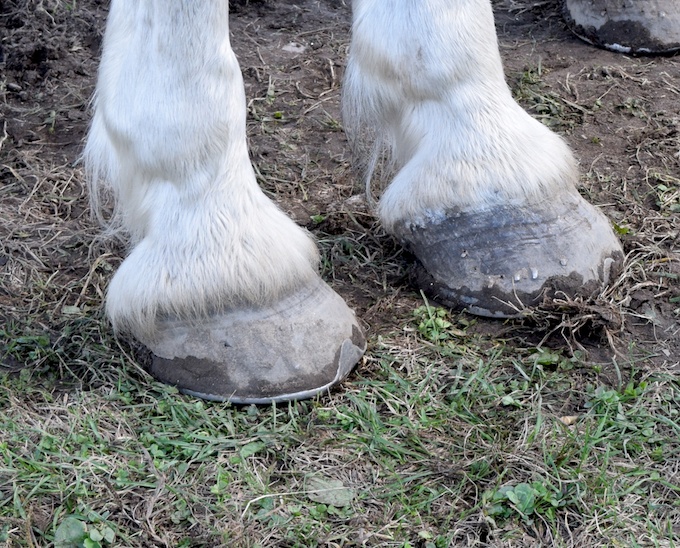
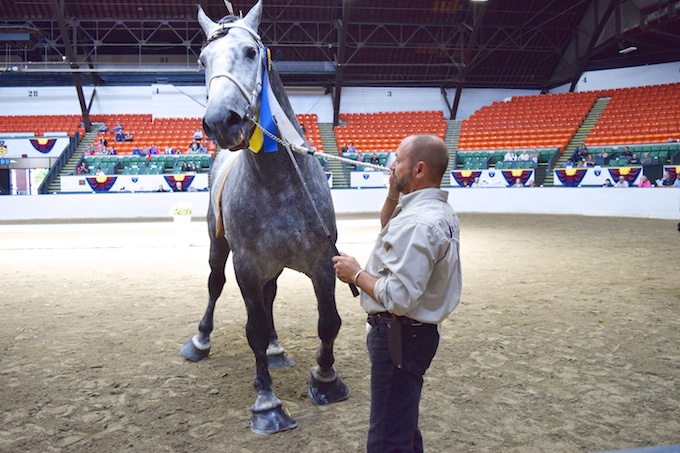

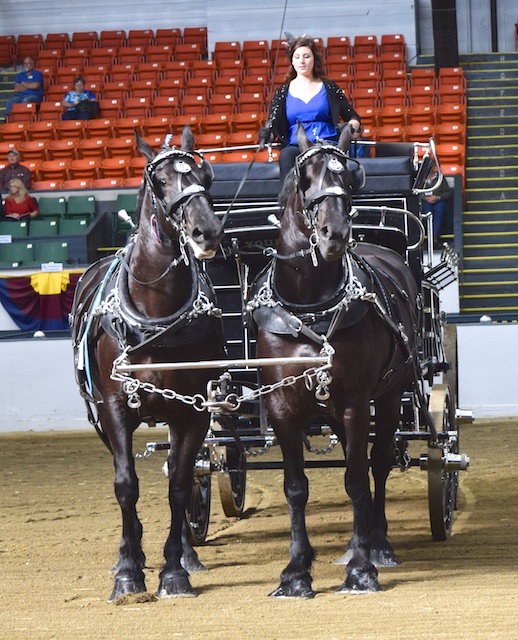
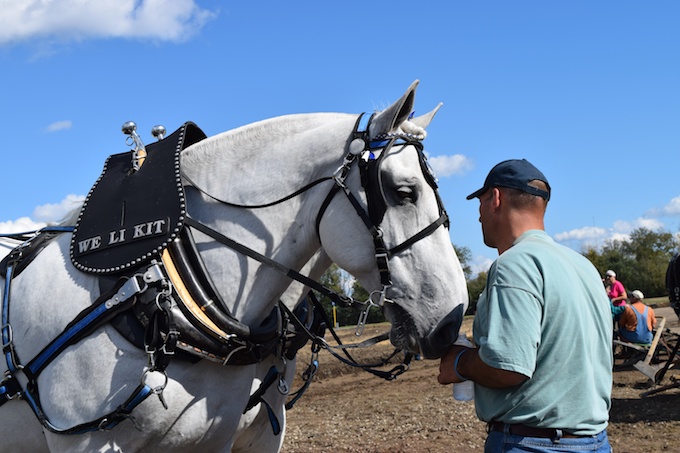

I never would have thought that there was such artifice in the show ring. Thank you for observing the details and having the knowledge of horses to realize what is fake and cruel. I much prefer the outside plow teams, strong and steady, horse and human.
The first thing I noticed in the picture of the show horses were the BIG feet. Thank you for explaining, I think they look ugly. That strap through the mouth then tied up to the ears looks just plain mean. I too love the natural plow horses. My dad had a Morgan when he was young, just beautiful. Later on when he saw the Morgan horses high stepping, he didn’t like it but said it was not a natural gait.
It amazes me that people say they love their animals all the while are being cruel. I WILL never understand it.
Oh, Terry. I watched it online after reading about it here. I was admiring the beauty of the horses and wanting to go to a congress one day until I read (and saw) this. Sigh….
yes, there are bad stories about the Amish and horses, but not on the farms of my Amish friends. I love to see them plow. I was watching yesterday when my friend Eli stopped and offered each horse an apple. I go to his farm to weave with his wife and friends. When he brings them in at night the boys clean them down including the feet. They stand calm and enjoy nudging the boys as they work. I could never be friends with anyone who didn’t treat their animals right including those who run puppy mills. It just isn’t worth having a ribbon to hang up seeing what abuse is done to get it.
I didn’t realize the stupid/cruel show ring mentality had reached into draft horses. That’s sad.
And the prize winning stallion is just wrong. Draft horses should not be that leggy! In fact, those legs don’t match that body-it’s just off visually.
I learned from a very wise horse woman…that a horse’s mouth should never have a “smile”. That lip crinkle chaps my hide. I know about the weighted hooves, chains, etc. It makes me nuts. When my girls showed Saddlebreds…life was a little more simplier. Who handled their horse best? Who could sit the seat better? This kind of showmanship makes me glad we do not show anymore. Love the plough horses though…beautiful!
you have touched on a point that keeps me away from going to county fairs.
and that’s the means and methods used to raise exceptional animals – of any kind.
i’m thinking now of pampered, trained cattle trusting their young owners, walking a ring, showing off and the next day slaughtered in the prize meat animal category.
i know. i eat meat. but that’s too much for me to watch and enjoy
i’ll go fry me a hamburger.
sigh…and we wonder why there’s so much pressure to be the “perfect” woman….when will we learn and appreciate the beauty of the natural-self?
Ah yes, it happens in every breed – of horse, dog, sheep, cow…. The “fashions” of the show ring have ruined more good animals, and entire breeds!
Ever since you put the World Percheron Congress link on your blog, I’ve been hooked on it. I sneak peaks at it all day while at the office, and have it on my laptop with speakers at home at night. So, thanks Terry, for giving me a fun thrill in the middle of a humdrum week.
I didn’t think bobbed tails and check reins were around any more- come to think of it, draft horses are barely around any more!
You’d think the novelty of a draft horse in itself would make the flashy “modifications” unnecessary.
Yes, there’s still a LOT of abuse around in the show world, be it horse or other animal.
Check reins go over the head and attach to the surcingle around the horse’s barrel. When their heads are held up so un-naturally high, the horses loose some of their functionality. The head is a large part of how they balance and use their front end. Used to be a lot of driving accidents due to check reins. Heads held high like that also cause pain along the back, not to mention in their tender mouths.
Large feet like that are not only ugly, but they cause injury to the horses. They tend to over step and hit the front legs with the hooves. Or they hit the front hoof with the back and tear off the shoes/bits of hoof. And as Terry mentioned, the hooves break up into cracks that can become painful.
I decades ago stopped going to the horse pulls. Most of the persons running a team were crueler than I cared to watch. Also, teams trained to pulled are so diametrically opposite how you want a working horse to behave, that they usually can not used for work.
I love watching beautiful animals, but not when what I see is brought about by artifice.
This is why I don’t compete in horse shows any longer. As a wise man once said: “Whenever animals or children are involved in making someone money, the animals or children are bound to lose.”
I wish we could exert more pressure on the Horse Show and Breed Associations to change the standards of what ‘winning’ looks like.
(It’s also one of the reasons I’m much less interested in the “Parsons Terrier” now that the AKC has gotten ahold of them. I’ll stick with my ‘JRTs’– the ‘type’, not breed, of working terriers I love so much.
So sad…:(
Tracy
I’ll never understand that mentality. :(
Good morning, all! Good job, Terry! It’s terrible to see what has happened to Morgans, Saddlebreds, quarter horses in the name of high-style showing.
I took the liberty of posting a link to this to a favorite website/message board discussing animal-powered farming, Rural Heritage — thought you might be interested in the response there:
http://www.ruralheritage.com/messageboard/frontporch/18970.htm
Lynn
Thanks for sharing, and it’s good to hear that there are others in the horse community who are as saddened as I am by the sight of work horses bred to be leggy high-steppers.
Y’know, reading further toward the bottom of the post I received answer to a question I was going to pose: if you ever heard of the “check reins” that hold their heads erect. I first heard of them while reading “Black Beauty”, though they called them “Bearing Reins”. As described in the book, they prevented the horse from putting it’s full power into it’s work, aside from being a nuisance to them. And the feet they showed? I’m no horseman, but even I can see those hoofs are poor condition. It’s like seeing the pictures of “bound feet” other cultures used to do to women. Almost wonder how they get away with this stuff.